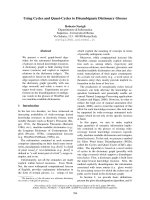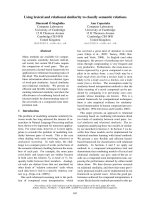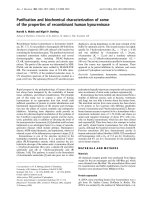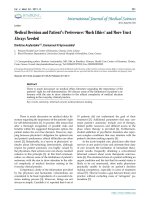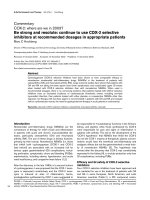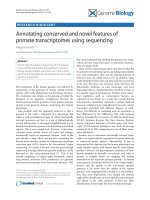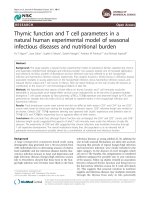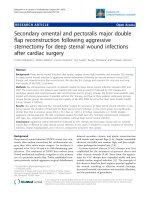Báo cáo y học: " Using patient and physician perspectives to develop a shared decision-making framework for colorectal cancer" pptx
Bạn đang xem bản rút gọn của tài liệu. Xem và tải ngay bản đầy đủ của tài liệu tại đây (197.04 KB, 5 trang )
BioMed Central
Page 1 of 5
(page number not for citation purposes)
Implementation Science
Open Access
Study protocol
Using patient and physician perspectives to develop a shared
decision-making framework for colorectal cancer
Marisa Leon-Carlyle
1
, Gillian Spiegle
1
, Selina Schmocker
1
, Anna Gagliardi
1,2
,
David Urbach
1,2
and Erin Kennedy*
1,2
Address:
1
Department of Surgery, Toronto General Hospital, Toronto, Ontario, Canada and
2
Department of Health Policy, Management and
Evaluation, University of Toronto, Toronto, Ontario, Canada
Email: Marisa Leon-Carlyle - ; Gillian Spiegle - ; Selina Schmocker - ;
Anna Gagliardi - ; David Urbach - ; Erin Kennedy* -
* Corresponding author
Abstract
Background: Colorectal cancer is the third leading cause of death from cancer worldwide with
over 900,000 diagnoses and 639,000 deaths each year. Although shared decision making is broadly
advocated as a mechanism by which to achieve patient-centred care, there has been little
investigation of patient and physician shared decision-making preferences and practices or the
outcomes associated with shared decision making in the context of colorectal cancer.
Aim: The aim of this study is to determine patient and physician attitudes towards the use of
shared decision making in the setting of colorectal cancer.
Methods: Standard principles of qualitative research will be used to sample and interview 20
colorectal cancer patients in each of three tertiary care hospitals (n = 60) and 15 surgeons,
radiation oncologists, and medical oncologists (n = 45) affiliated with cancer centres. The interview
questions will be guided by a conceptual framework defining patient and physician factors that
influence the shared decision-making process and associated outcomes in the setting of colorectal
cancer. An inductive, grounded approach will be used by two investigators to independently analyze
the interview transcripts. These investigators will meet to compare and achieve consensus on
themes that will be tabulated to compare barriers, enablers, and outcomes of shared decision
making by patient, physician, and contextual factors.
Discussion: This study is the first to examine both patient and physician perspectives on the use
of shared decision making for colorectal cancer in North America or elsewhere. It will provide a
framework that can be used to describe the shared decision-making process and its outcomes, and
evaluate strategies to facilitate this process for patients with colorectal cancer.
Background
Colorectal cancer is the third leading cause of death from
cancer worldwide, affecting 639,000 men and women
annually [1]. The mainstay of treatment for colon cancer
is surgery [2]. Following surgery, adjuvant chemotherapy
is recommended for patients with stage three and stage
four colon cancer, and follow-up for all stages is contin-
ued for approximately five years [2]. Patients with early
Published: 24 December 2009
Implementation Science 2009, 4:81 doi:10.1186/1748-5908-4-81
Received: 27 October 2009
Accepted: 24 December 2009
This article is available from: />© 2009 Leon-Carlyle et al; licensee BioMed Central Ltd.
This is an Open Access article distributed under the terms of the Creative Commons Attribution License ( />),
which permits unrestricted use, distribution, and reproduction in any medium, provided the original work is properly cited.
Implementation Science 2009, 4:81 />Page 2 of 5
(page number not for citation purposes)
rectal cancer (stage one) follow the same treatment algo-
rithm as for colon cancer, while patients with stage two
and three rectal cancer usually receive pre-operative chem-
oradiation for five weeks, followed by surgery six to eight
weeks after the completion of their chemoradiation, and
then receive post-operative chemotherapy [2]. Similar to
colon cancer, follow-up for all stages of rectal cancer is
continued for approximately five years. Following treat-
ment for colorectal cancer, patients will experience long-
term changes in bowel function that include increased
number of bowel movements and urgency, as well as
noticeable changes in sexual and bladder function [3-6].
These are profoundly important issues that must be con-
sidered by both the patient and the surgeon in order to
plan treatment that is most consistent with the patient's
values and lifestyle. Recently, several national research
bodies have identified patient-centred care as a priority
research theme [7,8]. Patient-centred care is defined as a
'collaboration between informed, respected patients and
their families and a coordinated healthcare team to
achieve quality healthcare' with the focus on the participa-
tion and engagement of the patient. Although several
models of the patient-physician encounter have been
described, shared decision making is broadly advocated as
a mechanism by which to achieve patient-centred care
[9,10] and has been shown to significantly increase
patient knowledge, improve patient satisfaction with
medical care and quality of life, and reduce anxiety and
decisional conflict [11,12]. Shared decision making is
characterized by a two-way flow of information during
which the physician shares technical information (diag-
nosis, treatment alternatives, risks, benefits, outcomes),
and the patient shares personal information during the
encounter (lifestyle, work and family responsibilities,
relationships, beliefs, fears) that the physician has no way
of knowing except through direct communication with
the patient [9,10]. Following this, both the patient and
physician work together towards a final treatment deci-
sion.
Although most patients prefer an active or shared role in
treatment decision making, their preferred roles are often
not achieved [13-15]. Of 233 cancer patients attending
outpatient clinic, 63% preferred an active role or shared
role in decision making, but only 34% achieved this role
[13,14]. In addition, patients who achieved a shared role
in treatment decision making were more satisfied with the
consultation and the information and emotional support
received by their physician compared to those who
achieved passive or active roles [13,16]. Despite surveys
reporting that physicians are aware of what shared deci-
sion making is and have positive attitudes towards its use,
implementation into clinical practice remains challenging
[17-21]. The reasons for this seem to be lack of time,
resources, and suitability of the decision aid for individual
patients [21,22].
Aims
The aims of this study are: to explore patients' and physi-
cians' attitudes towards the use of shared decision making
in the setting of colorectal cancer; to identify and explore
the enablers and barriers to the use of shared decision
making in the setting of colorectal cancer; and identify
and explore strategies to promote shared decision making
in the setting of colorectal cancer.
Methods
Overview
Prior to the start of this project, ethics approval will be
obtained. Standard principles of qualitative research
methods will be used to conduct interviews with colorec-
tal cancer patients and their physicians to learn whether
and how shared decision making is taking place, the fac-
tors influencing this process, associated outcomes, and
suggestions for improving shared decision making for
colorectal cancer.
Conceptual framework
Despite the considerable challenges and trade-offs associ-
ated with decisions for colorectal cancer, there has been
little investigation into the shared decision-making prefer-
ences, practices, or outcomes associated with patients and
physicians in the setting of colorectal cancer in Canada or
elsewhere. We interviewed Ontario colorectal cancer
patients who varied by age, gender, and stage of care, and
found that that involvement in treatment decision mak-
ing was considered very important by all patients [23].
Others studying the decisional support needs of patients
with colorectal cancer have found that patient needs for
information are high, and younger, female patients were
more likely to prefer an active role in treatment decision
making [24,25]. In addition, trust in the physician, having
an emotional support network, and the perception that
the patient's condition and treatment was considered
important by the healthcare team also influenced colorec-
tal cancer patients desire for involvement in treatment
decision making, and was considered as important as the
cancer information they received [24,25]. To date, no
existing model of shared decision making incorporates
the multiple factors that can influence this practice, the
various elements of shared decision making or associated
outcomes that have been discussed in the context of color-
ectal cancer. Therefore, we have combined these factors
within the following conceptual framework (Figure 1)
that will be used to define our research questions,
approach, and data collection tools.
Sampling and recruitment
Interviews will be conducted with 20 patients in each of
three tertiary care teaching hospitals in a single large
urban city, for a total of 60 interviews. These sites were
chosen because they offer access to a high volume of
colorectal cancer patients and because they maintain a
Implementation Science 2009, 4:81 />Page 3 of 5
(page number not for citation purposes)
clinical database that prospectively follow all colorectal
cancer patients by which patients can be identified. Using
these databases, patients will be selected that vary in non-
mutually exclusive fashion by age (65 years or less, greater
than 65 years), gender, education level (+/- university
degree), and context (colon cancer, rectal cancer, receipt
of radiotherapy, presence of a stoma). Eligible patients
must be at least 18 years of age, understand English, with
confirmed colorectal cancer. Patients will be contacted by
mail with an interview invitation and consent form. This
will take place as soon after treatment as possible to min-
imize recall bias. Non-responders will be contacted by tel-
ephone to request participation.
Interviews will be conducted with 15 surgeons, medical
oncologists, and radiation oncologists (total n = 45) who
care for patients with colorectal cancer and are affiliated
with province based cancer centres. Surgeons, medical
oncologists, and radiation oncologists will be identified
through Cancer Care Ontario, the provincial cancer
agency. Physicians will be selected that vary in non-mutu-
ally exclusive fashion by age (<50 years, >50 years), gen-
der, years in practice (≤ 5 years, 6 to 10 years, >10 year)
and geographic location (academic, community centre).
Eligible physicians will be contacted by mail with an inter-
view invitation and consent form. Non-responders will be
contacted by telephone to request participation.
We will not seek interviews with physician-patient dyads
because we are not measuring concordance between
patient preference and actual receipt of shared decision
making. Hence, even if physicians decline to participate
we will seek interviews with their patients, and vice versa.
To encourage participation, we will use strategies to
increase survey response rates, including a hand signed,
personalized cover letter on institutional letterhead and a
pre-addressed, stamped return envelope [26,27].
Data collection
Semi-structured interviews will be conducted, and all
interviews will be audio-recorded and transcribed by an
external professional. A single individual will conduct all
of the interviews to enhance validity by maintaining inter-
nal consistency.
The main objectives of the patient interviews are to
explore: patients' perceptions of the information they
received and were asked to provide during treatment deci-
sion making; patients' perceptions of the extent to which
they participated in treatment decision making and their
preferred level of participation (role-matching); how sat-
isfied patients were with their involvement in treatment
decision making; and patients' perceptions on how the
treatment decision-making process could be improved.
The main objectives of the physician interviews are to
explore: physicians' perceptions of what shared decision
Conceptual framework for shared decision making during the surgical consultationFigure 1
Conceptual framework for shared decision making during the surgical consultation.
Patient Factors
- Gender
- Age
- Education level
- Perceived urgency
- Trust in physician
- Emotional support network
Physician Factors
- Gender
- Age (years in practice)
- Specialization
- Communication training
- Attitudes/beliefs
- Use of aids/other information
Shared decision-making
outcome
Patients
Satisfaction with:
- Role
- Information
- Treatment decision
Physician
Satisfaction with:
- Job
- Patient relationship
Shared decision making
(surgical consultation)
Process
- Information exchange
- Deliberation
- Decision
Content
Cancer-related
- Type of surgical procedure
- Side effects adjuvant therapy
- Recurrence
Care-related
- Getting on with life
- Quality of life
Colorectal Cancer Context
- Col
on cancer/rectal cancer
- Receipt of radiotherapy
- Presence of stoma
- Post-operative complication
Implementation Science 2009, 4:81 />Page 4 of 5
(page number not for citation purposes)
making is; the extent to which physicians use and/or facil-
itate shared decision making; physicians' perceptions of
the usefulness of shared decision making; and strategies
used by physicians to incorporate shared decision making
into their clinical practice. Prior to the beginning of the
study, the patient and physician interviews will be pilot
tested on a small number of patients and physicians to
refine wording and flow of questions. Interview guides for
the patients and physicians interviews will be based on
the conceptual framework developed for this study.
Data analysis
Standard principles of qualitative research will be used to
sample patients and physicians representing various char-
acteristics, contexts, and settings. Hence, sampling will be
purposive to select individuals whose opinions may vary
according to these attributes. In qualitative research
detailed information from a representative rather than a
large number of cases is needed. Sample size is capped
when no further unique themes emerge from successive
interviews (informational redundancy) [28]. This is deter-
mined at the time of the data analysis that is concurrent
with the data collection. If information redundancy is not
achieved in patient or physician subcategories, additional
interviews will be conducted.
An inductive, grounded approach will be used for qualita-
tive analysis of interview transcripts using constant com-
parative analysis. This means that themes will be allowed
to emerge from the collected data, and progress through
three defined processes: description, categorical/concep-
tual ordering, and theorizing [28-31]. This involves
repeated reading of transcripts, development of a coding
scheme reflecting unique ideas, application of the coding
scheme to transcript text, and grouping of coded text by
theme. Consistent with constant comparative analysis,
open and axial coding of interview transcripts will occur
simultaneously, as data collection and analysis are con-
current [30,31]. Open coding recognizes ideas or concepts
identified by study participants by analyzing transcripts
line-by-line in their entirety, and then groups concepts
together to form categories and subcategories, often using
participant's own words as code names to ensure ground-
edness [30,31]. In this initial stage of constant compara-
tive analysis, data is coded in every way possible to
uncover all ideas.
Next, axial coding will be used to make connections
between categories and subcategories of codes. Codes gen-
erated from open coding will be collapsed and grouped
into mutually exclusive categories focusing on three inter-
related aspects of Strauss and Corbin's (1990) coding par-
adigm: individual actions or behaviours, situational
context, and consequences of the behaviours [28]. Repeat-
ing ideas will be assembled into themes based on content
similarity. A theme is an implicit topic that organizes a
group of repeating ideas. Themes will be similarly
reviewed and assembled into abstract theoretical con-
structs based on their relation to one another and their
ability to explain factors influencing shared decision-mak-
ing preferences and behaviours. Theoretical constructs
organize themes into larger, more abstract ideas. Themes
and theoretical constructs will be tabulated to compare
barriers, enablers, and outcomes of shared decision mak-
ing by patient, physician, and contextual factors. Finally
theoretical constructs will be organized into a theoretical
narrative, which summarizes what we have learned and
bridges the research objectives with participants' subjec-
tive experience.
To improve the reliability of these findings, two investiga-
tors will individually analyze and code all transcripts.
They will meet to compare findings and achieve consen-
sus through discussion. Collaborative coding by multiple
individuals minimizes the chance that important the-
matic ideas are overlooked, and ensures that the organiza-
tion of the data and the resulting conceptual theory is
transparent [28].
Discussion
The results of this study will provide better understanding
of the current use and enablers and barriers to the use of
shared decision making from both the patient and physi-
cian perspective in the setting of colorectal cancer. This
study is the first to examine both patient and physician
perspectives on the use of shared decision making for
colorectal cancer in Canada or elsewhere. Fundamentally,
it is an important study because it will provide a frame-
work that can be used to describe the shared decision-
making process and to make recommendations about
how to best facilitate this process. The development of a
framework is the critical first step necessary to explore the
information and decision support needs of colorectal can-
cer patients.
Competing interests
The authors declare that they have no competing interests.
Authors' contributions
All authors participated in the design of the study. AG and
EDK developed the qualitative research methods. EDK
conducted the interviews and was responsible for the
overall execution of the study. EDK, GS, SS, and MLC
reviewed the interview transcripts that have been con-
ducted. AG led qualitative data analysis methods. DU
assisted with interpretation of synthesized data analyses.
All authors read and approved the final manuscript.
Acknowledgements
This study was funded by the Canadian Institutes of Health Research, ref-
erence number IHP-94129.
Publish with BioMed Central and every
scientist can read your work free of charge
"BioMed Central will be the most significant development for
disseminating the results of biomedical research in our lifetime."
Sir Paul Nurse, Cancer Research UK
Your research papers will be:
available free of charge to the entire biomedical community
peer reviewed and published immediately upon acceptance
cited in PubMed and archived on PubMed Central
yours — you keep the copyright
Submit your manuscript here:
/>BioMedcentral
Implementation Science 2009, 4:81 />Page 5 of 5
(page number not for citation purposes)
References
1. World Health Organization: Cancer. [ />factsheets/fs297/en/].
2. Nelson H, Petrelli N, Carlin A, Couture J, Fleshman J, Guillem J, Mie-
dema B, Ota D, Sargent D: Guidelines 2000 for colon and rectal
cancer surgery. J Natl Cancer Inst 2001, 938:583-96.
3. Temple LK, Wong WD, Minsky B: The impact of radiation on
functional outcomes in patients with rectal cancer and
sphincter preservation. Semin Radiat Oncol 2003, 134:469-77.
4. Peeters KC, Velde CJ van de, Leer JW, Martijn H, Junggeburt JM,
Kranenbarg EK, Steup WH, Wiggers T, Rutten HJ, Marijnen CA: Late
side effects of short-course preoperative radiotherapy com-
bined with total mesorectal excision for rectal cancer:
increased bowel dysfunction in irradiated patients a Dutch
colorectal cancer group study. J Clin Oncol 2005, 2325:6199-206.
5. Dahlberg M, Glimelius B, Graf W, Pahlman L: Preoperative irradi-
ation affects functional results after surgery for rectal can-
cer: results from a randomized study. Dis Colon Rectum 1998,
415:543-9. discussion 549-51
6. Hendren SK, O'Connor BI, Liu M, Asano T, Cohen Z, Swallow CJ,
Macrae HM, Gryfe R, McLeod RS: Prevalence of male and female
sexual dysfunction is high following surgery for rectal cancer.
Ann Surg 2005, 2422:212-23.
7. Law S: Listening for direction III. National consultation on
health services and policy issues 2007-2010. Canadian Health
Services Research Foundation and Canadian Institute of Health
Research, Institute of Health Services and Policy Research; 2008:2-28.
8. Institute of Medicine: Crossing the Quality Chasm: A New
Health System for the Twenty-first Century. National Acade-
mies Press: Washington; 2001.
9. Charles C, Gafni A, Whelan T: Shared decision-making in the
medical encounter: what does it mean? (or it takes at least
two to tango). Soc Sci Med 1997, 445:681-92.
10. Charles C, Gafni A, Whelan T: Decision-making in the physician-
patient encounter: revisiting the shared treatment decision-
making model. Soc Sci Med 1999, 495:651-61.
11. O'Connor AMSD, Entwistle V, Llewellyn-Thomas H, Rovner D, Hol-
mes-Rovner M, Tait V, Tetroe J, Fiset V, Barry M, Jones J: Decision
aids for people facing health treatment or screening deci-
sions (review). The Cochrane Collaboration, The Cochrane
Library; 2005.
12. O'Connor AM, Bennett C, Stacey D, Barry MJ, Col NF, Eden KB,
Entwistle V, Fiset V, Holmes-Rovner M, Khangura S, Llewellyn-Tho-
mas H, Rovner DR: Do patient decision aids meet effectiveness
criteria of the international patient decision aid standards
collaboration? A systematic review and meta-analysis. Med
Decis Making 2007, 275:554-74.
13. Gattellari M, Butow PN, Tattersall MH: Sharing decisions in can-
cer care. Soc Sci Med 2001, 5212:1865-78.
14. Gattellari M, Voigt KJ, Butow PN, Tattersall MH: When the treat-
ment goal is not cure: are cancer patients equipped to make
informed decisions? J Clin Oncol 2002, 202:503-13.
15. Braddock CH, Edwards KA, Hasenberg NM, Laidley TL, Levinson W:
Informed decision making in outpatient practice: time to get
back to basics. JAMA 1999, 28224:2313-20.
16. Kiesler DJ, Auerbach SM: Optimal matches of patient prefer-
ences for information, decision-making and interpersonal
behavior: evidence, models and interventions. Patient Educ
Couns 2006, 613:319-41.
17. Graham ID, Logan J, O'Connor A, Weeks KE, Aaron S, Cranney A,
Dales R, Elmslie T, Hebert P, Jolly E, Laupacis A, Mitchell S, Tugwell
P: A qualitative study of physicians' perceptions of three deci-
sion aids. Patient Educ Couns 2003, 503:279-83.
18. Shepherd HL, Tattersall MH, Butow PN: The context influences
doctors' support of shared decision-making in cancer care.
Br J Cancer 2007, 971:6-13.
19. Charles C, Gafni A, Whelan T: Self-reported use of shared deci-
sion-making among breast cancer specialists and perceived
barriers and facilitators to implementing this approach.
Health Expect 2004, 74:338-48.
20. Holmes-Rovner M, Valade D, Orlowski C, Draus C, Nabozny-Valerio
B, Keiser S: Implementing shared decision-making in routine
practice: barriers and opportunities. Health Expect 2000,
33:182-191.
21. Brace C, Schmocker S, Huang H, Victor C, McLeod RS, Kennedy ED:
Physicians' awareness and attitudes towards decision aids for
cancer patients. Canadian Journal of Surgery 2008, 51(Suppl):A45.
22. Gravel K, Legare F, Graham ID: Barriers and facilitators to
implementing shared decision-making in clinical practice: a
systematic review of health professionals' perceptions. Imple-
ment Sci 2006, 1:16.
23. Gagliardi AR, Lemieux-Charles L, Brown AD, Sullivan T, Goel V: Bar-
riers to patient involvement in health service planning and
evaluation: an exploratory study. Patient Educ Couns 2008,
702:234-41.
24. Butow PN, Solomon M, Young JM, Whelan T, Salkeld G, Wilson K,
Harrison JD, Hruby G, Mansour O, Kennedy N, Tattersall MH: Con-
sumer impact of an interactive decision aid for rectal cancer
patients offered adjuvant therapy. Colorectal Dis 2006,
88:676-82.
25. Salkeld G, Solomon M, Short L, Butow PN: A matter of trust
patient's views on decision-making in colorectal cancer.
Health Expect 2004, 72:104-14.
26. Asch DA, Jedrziewski MK, Christakis NA: Response rates to mail
surveys published in medical journals. J Clin Epidemiol 1997,
5010:1129-36.
27. Edwards PJ, Roberts I, Clarke MJ, Diguiseppi C, Wentz R, Kwan I,
Cooper R, Felix LM, Pratap S: Methods to increase response to
postal and electronic questionnaires. Cochrane Database Syst
Rev 2009.
28. Strauss A: Basics of qualitative research. Thousand Oaks, Cali-
fornia: Sage Publications; 1998.
29. Auerbach C: Qualitative data: an introduction to coding and
analysis. New York: New York University Press; 2003.
30. Pope C, Ziebland S, Mays N: Qualitative research in healthcare.
Analysing qualitative data. BMJ 2000, 3207227:114-6.
31. Mays N, Pope C: Qualitative research in healthcare. Assessing
quality in qualitative research. BMJ 2000, 3207226:50-2.
